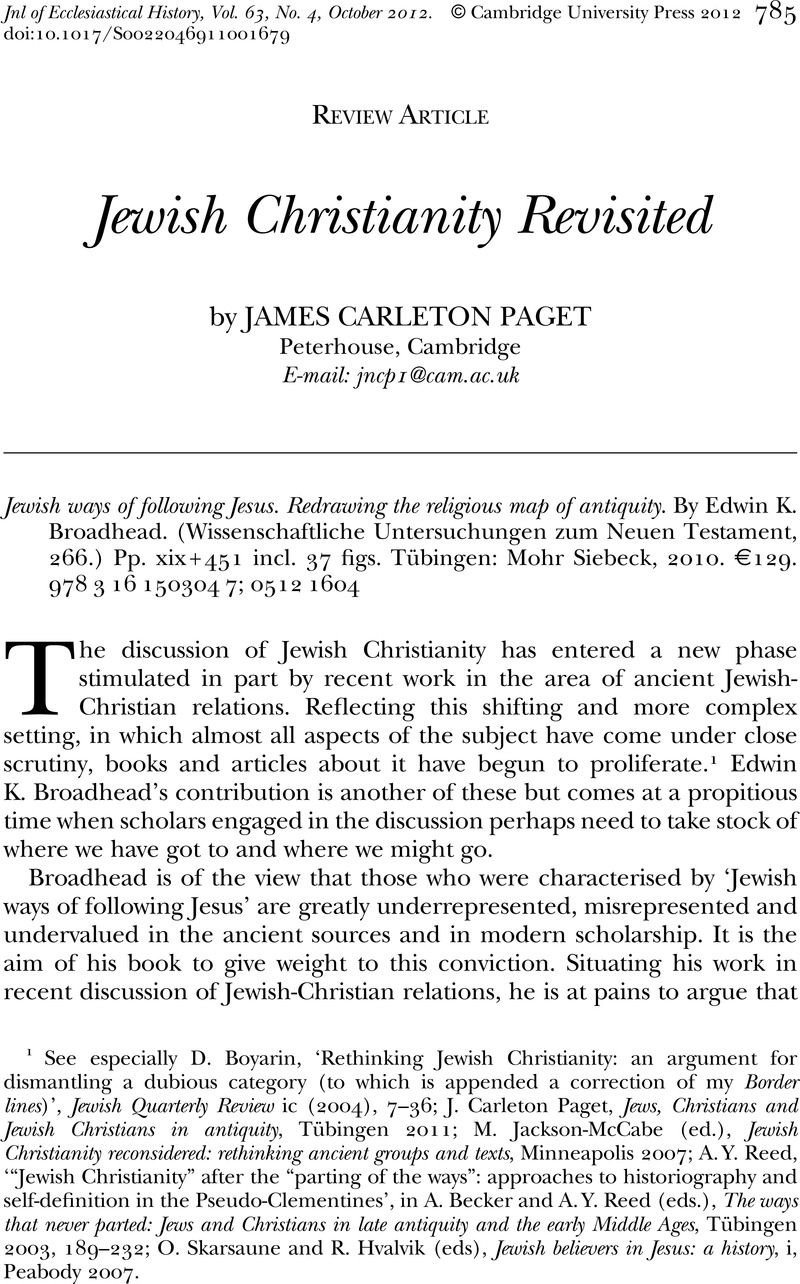Published online by Cambridge University Press: 17 September 2012

1 See especially Boyarin, D., ‘Rethinking Jewish Christianity: an argument for dismantling a dubious category (to which is appended a correction of my Border lines)’, Jewish Quarterly Review ic (2004), 7–36Google Scholar; Paget, J. Carleton, Jews, Christians and Jewish Christians in antiquity, Tübingen 2011Google Scholar; Jackson-McCabe, M. (ed.), Jewish Christianity reconsidered: rethinking ancient groups and texts, Minneapolis 2007Google Scholar; A. Y. Reed, ‘“Jewish Christianity” after the “parting of the ways”: approaches to historiography and self-definition in the Pseudo-Clementines’, in A. Becker and A. Y. Reed (eds.), The ways that never parted: Jews and Christians in late antiquity and the early Middle Ages, Tübingen 2003, 189–232; Skarsaune, O. and Hvalvik, R. (eds), Jewish believers in Jesus: a history, i, Peabody 2007Google Scholar.
2 For a discussion of the need for a polythetic definition of Jewish Christianity see Jackson-McCabe, Jewish Christianity, 33ff., here heavily dependent upon the work of J. Z. Smith.
3 The seminal essay critiquing the ‘partings’ paradigm is Lieu, J., ‘“The partings of the ways”: theological construct or historical reality’, in her Neither Jew nor Greek: constructing early Christianity, Edinburgh 2002, 11–30Google Scholar. A swathe of critical literature has followed this. See especially Boyarin, D., Border lines: the partition of Judaeo-Christianity, Philadelphia 2004CrossRefGoogle Scholar; Becker and Reed, The ways that never parted, noting especially here the introductory essay by the editors and the contribution of Boyarin; and A. Y. Reed, ‘“Jewish Christianity” as counter-history? The Apostolic past in Eusebius’ Ecclesiastical history and the Pseudo-Clementine Homilies’, in G. Gardner and K. L. Osterloh (eds.), Antiquity in antiquity: Jewish and Christian pasts in the Greco-Roman world, Tübingen 2008, 173–216. Carleton Paget, Jews, 3–24, gives a summary of the shifting landscape of the debate with relevant bibliography.
4 See Carleton Paget, Jews, 12–13.
5 Klijn, A. F. J. and Reinink, G. J., Patristic evidence for Jewish-Christian sects, Leiden 1973CrossRefGoogle Scholar.
6 For a recent and succinct analysis of Epiphanius' description of the Ebionites see O. Skarsaune, ‘The Ebionites’, in Skarsaune and Hvalvik, Jewish believers, 450–61.
7 Boyarin, Border lines, 207–10.
8 See Reed, ‘“Jewish Christianity” as counter-history’, 211.
9 S. Pines, ‘The Jewish Christians of the early Christian centuries according to a new source’, in Proceedings of the Israel Academy of Science and Humanities, ii, Jerusalem 1968, 237–309, repr. in G. Stroumsa (ed.), The collected works of Shlomo Pines, IV: Studies in the history of religion, Jerusalem 1996, 211–86.
10 See n. 1 above. Skarsaune, who is the main contributor to the volume, is keen to broaden the number of early Christian authors one might term ‘Jewish Christian’, though this has a great deal to do with his own definition of the term.
11 On this see Skarsaune, ‘Ebionites’, 448, and relevant bibliography.